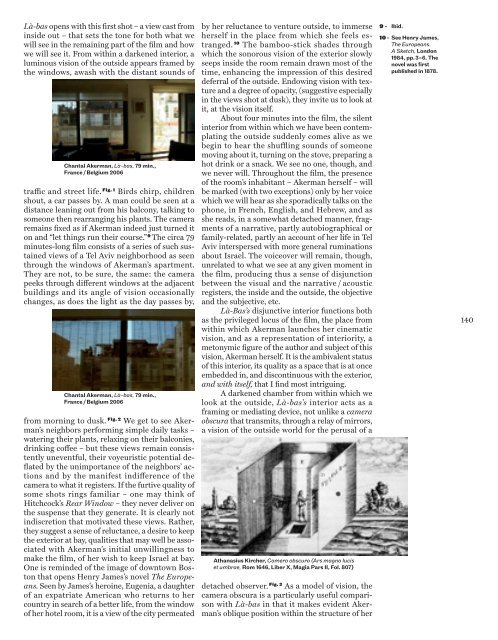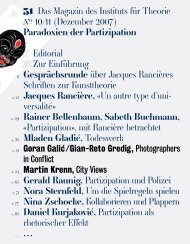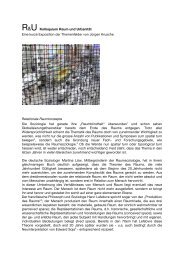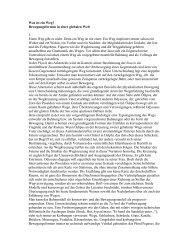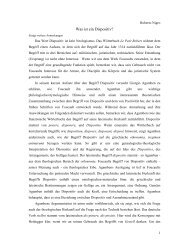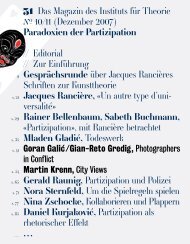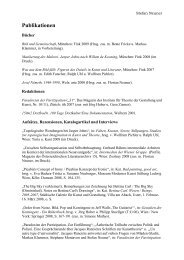Heft - Institut für Theorie ith
Heft - Institut für Theorie ith
Heft - Institut für Theorie ith
Erfolgreiche ePaper selbst erstellen
Machen Sie aus Ihren PDF Publikationen ein blätterbares Flipbook mit unserer einzigartigen Google optimierten e-Paper Software.
Là-bas opens w<strong>ith</strong> this first shot – a view cast from<br />
inside out – that sets the tone for both what we<br />
will see in the remaining part of the film and how<br />
we will see it. From w<strong>ith</strong>in a darkened interior, a<br />
luminous vision of the outside appears framed by<br />
the windows, awash w<strong>ith</strong> the distant sounds of<br />
Chantal Akerman, Là-bas, 79 min.,<br />
France / Belgium 2006<br />
tra∞c and street life. Fig. 1 Birds chirp, children<br />
shout, a car passes by. A man could be seen at a<br />
distance leaning out from his balcony, talking to<br />
someone then rearranging his plants. The camera<br />
remains fixed as if Akerman indeed just turned it<br />
on and “let things run their course.” 9 The circa 79<br />
minutes-long film consists of a series of such sustained<br />
views of a Tel Aviv neighborhood as seen<br />
through the windows of Akerman’s apartment.<br />
They are not, to be sure, the same: the camera<br />
peeks through di≠erent windows at the adjacent<br />
buildings and its angle of vision occasionally<br />
changes, as does the light as the day passes by,<br />
Chantal Akerman, Là-bas, 79 min.,<br />
France / Belgium 2006<br />
from morning to dusk. Fig. 2 We get to see Akerman’s<br />
neighbors performing simple daily tasks –<br />
watering their plants, relaxing on their balconies,<br />
drinking co≠ee – but these views remain consistently<br />
uneventful, their voyeuristic potential deflated<br />
by the unimportance of the neighbors’ actions<br />
and by the manifest indi≠erence of the<br />
camera to what it registers. If the furtive quality of<br />
some shots rings familiar – one may think of<br />
Hitchcock’s Rear Window – they never deliver on<br />
the suspense that they generate. It is clearly not<br />
indiscretion that motivated these views. Rather,<br />
they suggest a sense of reluctance, a desire to keep<br />
the exterior at bay, qualities that may well be associated<br />
w<strong>ith</strong> Akerman’s initial unwillingness to<br />
make the film, of her wish to keep Israel at bay.<br />
One is reminded of the image of downtown Boston<br />
that opens Henry James’s novel The Europeans.<br />
Seen by James’s heroine, Eugenia, a daughter<br />
of an expatriate American who returns to her<br />
country in search of a better life, from the window<br />
of her hotel room, it is a view of the city permeated<br />
by her reluctance to venture outside, to immerse<br />
herself in the place from which she feels estranged.<br />
10 The bamboo-stick shades through<br />
which the sonorous vision of the exterior slowly<br />
seeps inside the room remain drawn most of the<br />
time, enhancing the impression of this desired<br />
deferral of the outside. Endowing vision w<strong>ith</strong> texture<br />
and a degree of opacity, (suggestive especially<br />
in the views shot at dusk), they invite us to look at<br />
it, at the vision itself.<br />
About four minutes into the film, the silent<br />
interior from w<strong>ith</strong>in which we have been contemplating<br />
the outside suddenly comes alive as we<br />
begin to hear the shuffling sounds of someone<br />
moving about it, turning on the stove, preparing a<br />
hot drink or a snack. We see no one, though, and<br />
we never will. Throughout the film, the presence<br />
of the room’s inhabitant – Akerman herself – will<br />
be marked (w<strong>ith</strong> two exceptions) only by her voice<br />
which we will hear as she sporadically talks on the<br />
phone, in French, English, and Hebrew, and as<br />
she reads, in a somewhat detached manner, fragments<br />
of a narrative, partly autobiographical or<br />
family-related, partly an account of her life in Tel<br />
Aviv interspersed w<strong>ith</strong> more general ruminations<br />
about Israel. The voiceover will remain, though,<br />
unrelated to what we see at any given moment in<br />
the film, producing thus a sense of disjunction<br />
between the visual and the narrative / acoustic<br />
registers, the inside and the outside, the objective<br />
and the subjective, etc.<br />
Là-Bas’s disjunctive interior functions both<br />
as the privileged locus of the film, the place from<br />
w<strong>ith</strong>in which Akerman launches her cinematic<br />
vision, and as a representation of interiority, a<br />
metonymic figure of the author and subject of this<br />
vision, Akerman herself. It is the ambivalent status<br />
of this interior, its quality as a space that is at once<br />
embedded in, and discontinuous w<strong>ith</strong> the exterior,<br />
and w<strong>ith</strong> itself, that I find most intriguing.<br />
A darkened chamber from w<strong>ith</strong>in which we<br />
look at the outside, Là-bas’s interior acts as a<br />
framing or mediating device, not unlike a camera<br />
obscura that transmits, through a relay of mirrors,<br />
a vision of the outside world for the perusal of a<br />
Athanasius Kircher, Camera obscura (Ars magna lucis<br />
et umbrae, Rom 1646, Liber X, Magia Pars II, Fol. 807)<br />
detached observer. Fig. 3 As a model of vision, the<br />
camera obscura is a particularly useful comparison<br />
w<strong>ith</strong> Là-bas in that it makes evident Akerman’s<br />
oblique position w<strong>ith</strong>in the structure of her<br />
9 - Ibid.<br />
10 - See Henry James,<br />
The Europeans.<br />
A Sketch, London<br />
1984, pp. 3–6. The<br />
novel was first<br />
published in 1878.<br />
140


